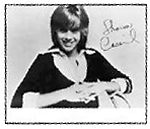This week’s adventure, like so many others, begins with the ramblings of a drunk.
A couple weekends ago, I made the trek down to Bob’s World Famous Java Jive, Tacoma’s coffeepot-shaped nightclub, for a rare U.S. appearance by the hardest-working karaoke act in Canada, Canned Hamm. Before the show, Lil’ Hamm and I were chatting, and as inevitably occurs when at least one homosexual is present and alcohol is within reach, talk turned to Carol Channing.
“Do you know about Skidoo?” asked Lil’ Hamm, beer dribbling from his chin. Never heard of it, I admitted. Hands all aflutter, Lil’ quickly summarized this forgotten 1968 Otto Preminger comedy about groovy young people butting heads with the establishment, featuring an unlikely cast for a movie about LSD, including Channing, Jackie Gleason, Mickey Rooney, Cesar Romero, Burgess Meredith, and, in his final motion picture appearance, Groucho Marx . . . as God.
Lil’ Hamm confessed he’d been hunting for the soundtrack album, then burst into a disturbing impersonation of the Hello, Dolly! star warbling about “flower power.” The score, he added, was composed by John Lennon’s drinking buddy Harry Nilsson, who not only made a cameo but sang the entirety of the final credits. This I had to hear.
To my surprise, the next morning I had no trouble tracking down an import CD featuring Skidoo, paired with another Nilsson soundtrack, The Point!, via the Internet. Alas, when the disc arrived, I was crushed to discover Skidoo wasn’t as perverse as I’d imagined. “The Cast and Crew” is a better-than-average novelty number, but the aforementioned Channing track is hardly camp enough to merit repeated spins, and “Garbage Can Ballet” excepted, instrumentals compose the bulk of the remainder.
Discouraged, I continued to the second half of the CD, The Point! And suddenly, things started looking up.
(At this juncture, I must admit I’ve never been a big Nilsson fan. In my youth, I remember being introduced to his 1972 top-10 ditty “Coconut” via an episode of The Muppet Show, but somehow his big hits, “Everybody’s Talkin'” and “Without You,” eluded my ears. Senior year of college, one of my housemates tried to turn me on to Nilsson, but I stopped paying attention after she mentioned his involvement in the movie adaptation of Popeye. Robin Williams? I think not.)
The Point!, which spawned “Me and My Arrow” (later recycled in a popular car commercial), tells the tale of Oblio, a little boy born into a community in which everything—the people, the buildings, the animals—literally has a point. Everything, that is, except Oblio, who is hopelessly roundheaded and is banished to the Pointless Forest as a consequence. Eventually, after many odd adventures, Oblio and his canine companion, Arrow, return home, having learned that everything—particularly that which seems pointless—has a point, including our hero.
While the album The Point!, which punctuates Nilsson’s slightly dated, hippie-era storyline with dreamy original songs, stands alone as a listening experience, to get the full effect you need to watch the animated film it was composed to accompany. Although the original TV version, which debuted on Feb. 2, 1971, as an ABC Movie of the Week, featured narration by Dustin Hoffman, the home video edition substitutes the infinitely more charismatic Ringo Starr.
Watching The Point! for the first time last week, with its pulsing colors, talking rocks, and Ringo’s goofy burr, I admit to thinking, “Someone was on drugs when they made this.” Then I recalled reading that during the making of Skidoo, Nilsson claimed he’d never taken LSD. How could I be so cynical about a children’s movie? I mean, this isn’t Pee-Wee’s Playhouse, for Christ’s sake.
But alas, further research revealed that Nilsson had ingested mind-altering drugs by the time he dreamt up this minor masterpiece. “I was on acid and I looked at the trees and I realized that they all came to points, and the little branches came to points, and the houses came to points. I thought, ‘Oh! Everything has a point, and if it doesn’t, then there’s a point to it,'” he told Dawn Eden in an interview for Goldmine, which was published in 1994, a few months after he died from heart disease at 52.
Regardless of its inspiration, 31 years later The Point! remains a loopy, kaleidoscopic romp that works equally well on an adult or juvenile level. (And, it must be added, it’s gloriously two-dimensional, the way God intended cartoons to be.) Unfortunately, although some video stores still rent the Ringo Starr version, it is currently unavailable commercially on either VHS or DVD. After listening to Skidoo, I can understand why nobody has bothered to rerelease Nilsson’s first foray into film, but The Point! deserves better.






